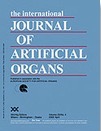Haluk Morgül and Nathanael Raschzok published their first results on "Tracking of primary human hepatocytes with clinical MRI: Initial results with Tat-peptide modified superparamagnetic iron oxide particles." in the March issue of IJAO (Int J Artif Organs 2008, 31:252-257): The transplantation of primary human hepatocytes is a promising approach in the treatment of specific liver diseases. However, little is known about the fate of the cells following application. Magnetic resonance imaging (MRI) could enable real-time tracking and long-term detection of transplanted hepatocytes. The use of superparamagnetic iron oxide particles as cellular contrast agents should allow for the non-invasive detection of labelled cells on high-resolution magnetic resonance images. Experiments were performed on primary human hepatocytes to transfer the method of detecting labelled cells via clinical MRI into human hepatocyte transplantation. For labelling, Tat-peptide modified nano-sized superparamagnetic MagForce particles were used. Cells were investigated via a clinical MR scanner at 3.0 Tesla and the particle uptake within single hepatocytes was estimated using microscopic examinations. The labelled primary human hepatocytes were clearly detectable by MRI, proving the feasibility of this new concept. Therefore, this method is a useful tool to investigate the effects of human hepatocyte transplantation and to improve safety aspects of this method.

